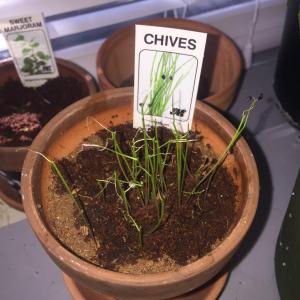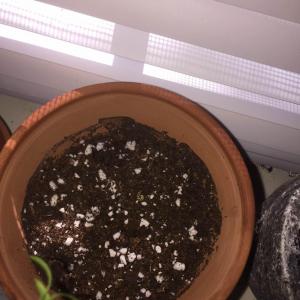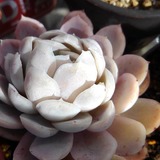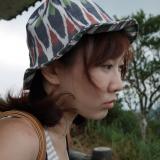文章
Miss Chen
2018年01月22日

Description: This is a herbaceous perennial plant about 2½–5' tall. At its base, there is a rosette of arching basal leaves. These basal leaves are 10-20" long and ½–1¼" across; they are medium green to yellowish green, glabrous, linear in shape, entire (toothless) along their margins, and often folded upward along their midveins. Leaf venation is parallel. A few alternate leaves occur along the central stem of this plant; they are similar to the basal leaves, except smaller in size. The central stem is light green, terete, relatively stout, and unbranched; it is usually glabrous below and pubescent with curly hairs above. The central stem terminates in a panicle of flowers about ¾–2' long and about one-half as much across. The lateral primary branches of this inflorescence are ascending, but not erect; they are somewhat longer toward the bottom and center of the inflorescence. Similar to the upper central stem, these floral branches are light green, terete, relatively stout, and pubescent with curly hairs.
At the base of each floral branch (including the pedicels), there is a linear-lanceolate bract up to ½" long that darkens and withers away with age. The pedicels (basal stalklets) of the flowers are about ¼–¾" long. Individual flowers are about ¾–1" across. Each flower has a white corolla with 6 spreading tepals, 6 stamens with white filaments, 3 white styles, and a light greenish yellow ovary. Individual tepals are lanceolate-oblong in shape, although they taper abruptly above their narrow bases. Just above their narrow bases, the tepals have 2 conspicuous glands that are yellow, green, or yellowish green. These glands secrete nectar. With age, the corollas become green or brownish purple. The flowers are replaced by ovoid-lanceoloid seed capsules up to 18 mm. (2/3") long. These capsules divide into 3 parts to release their seeds; each capsule contains 12 or more seeds. Individual seeds are 5-8 mm. long and about one-half as much across; they are straw-colored and somewhat irregular in shape. The root system is fibrous, short-rhizomatous, and relatively shallow. Clonal offsets can develop from the short rhizomes.

Cultivation: The preference is full or partial sun, wet to moist conditions, and fertile soil. Some standing water is tolerated if it is temporary. Several years of development are required before individual plants begin to flower.
Range & Habitat: The native Virginia Bunch-Flower occurs primarily in west-central Illinois, where it is rare and state-listed as 'threatened' (see Distribution Map). At one time, this plant was more common, but habitat destruction has resulted in population losses in several counties. In Illinois, habitats consist of damp prairies, especially along railroads, and wet ground along the bases of bluffs (these are often seeps). Outside of Illinois, Virginia Bunch-Flower has been found in open bottomland woodlands, damp meadows, swamps, marshes, fens, floating bogs, and roadside ditches. This conservative species is largely restricted to high quality habitats. To maintain populations of this plant within the state, cultivated plants should be used in prairie restorations.

Faunal Associations: Mostly flies and beetles visit the flowers of this plant, where they feed on the easy-to-access nectar, although some insect species may also feed on pollen. These floral visitors include Syrphid flies, Tachinid flies, blow flies (Lucilia spp.), Muscid flies, Anthomyiid flies, weevils, tumbling flower beetles, and flower scarab beetles. Some bees and wasps may also visit the flowers (Robertson, 1929). Because the foliage and roots of Virginia Bunch-Flower contain highly toxic alkaloids, they are not normally eaten by mammalian herbivores. This plant is especially poisonous to horses (Georgia, 1913).

Photographic Location: A prairie or sedge meadow at a nature preserve in Fayette County, Illinois. The photographs were taken by Keith & Patty Horn (Copyright © 2016).
Comments: Another species in the same genus, Melanthium woodii (Wood's Bunch-Flower), is a woodland species with wider leaves and reddish brown (maroon) flowers. The tepals of its flowers do not abruptly contract near their bases. Because of these differences, it is relatively easy to distinguish Wood's Bunch-Flower from Virginia Bunch-Flower. While there are other white-flowered Melanthium spp., they do not occur in Illinois. Some taxonomists prefer to merge the Melanthium genus with the Veratrum genus. When this happens, Virginia Bunchflower is referred to as Veratrum virginicum. Some taxonomists have divided the Lily family (Liliaceae) into several families, assigning the Melanthium genus to the Bunchflower family (Melanthiaceae). When it is in full bloom, Virginia Bunchflower is very showy and attractive.
At the base of each floral branch (including the pedicels), there is a linear-lanceolate bract up to ½" long that darkens and withers away with age. The pedicels (basal stalklets) of the flowers are about ¼–¾" long. Individual flowers are about ¾–1" across. Each flower has a white corolla with 6 spreading tepals, 6 stamens with white filaments, 3 white styles, and a light greenish yellow ovary. Individual tepals are lanceolate-oblong in shape, although they taper abruptly above their narrow bases. Just above their narrow bases, the tepals have 2 conspicuous glands that are yellow, green, or yellowish green. These glands secrete nectar. With age, the corollas become green or brownish purple. The flowers are replaced by ovoid-lanceoloid seed capsules up to 18 mm. (2/3") long. These capsules divide into 3 parts to release their seeds; each capsule contains 12 or more seeds. Individual seeds are 5-8 mm. long and about one-half as much across; they are straw-colored and somewhat irregular in shape. The root system is fibrous, short-rhizomatous, and relatively shallow. Clonal offsets can develop from the short rhizomes.

Cultivation: The preference is full or partial sun, wet to moist conditions, and fertile soil. Some standing water is tolerated if it is temporary. Several years of development are required before individual plants begin to flower.
Range & Habitat: The native Virginia Bunch-Flower occurs primarily in west-central Illinois, where it is rare and state-listed as 'threatened' (see Distribution Map). At one time, this plant was more common, but habitat destruction has resulted in population losses in several counties. In Illinois, habitats consist of damp prairies, especially along railroads, and wet ground along the bases of bluffs (these are often seeps). Outside of Illinois, Virginia Bunch-Flower has been found in open bottomland woodlands, damp meadows, swamps, marshes, fens, floating bogs, and roadside ditches. This conservative species is largely restricted to high quality habitats. To maintain populations of this plant within the state, cultivated plants should be used in prairie restorations.

Faunal Associations: Mostly flies and beetles visit the flowers of this plant, where they feed on the easy-to-access nectar, although some insect species may also feed on pollen. These floral visitors include Syrphid flies, Tachinid flies, blow flies (Lucilia spp.), Muscid flies, Anthomyiid flies, weevils, tumbling flower beetles, and flower scarab beetles. Some bees and wasps may also visit the flowers (Robertson, 1929). Because the foliage and roots of Virginia Bunch-Flower contain highly toxic alkaloids, they are not normally eaten by mammalian herbivores. This plant is especially poisonous to horses (Georgia, 1913).

Photographic Location: A prairie or sedge meadow at a nature preserve in Fayette County, Illinois. The photographs were taken by Keith & Patty Horn (Copyright © 2016).
Comments: Another species in the same genus, Melanthium woodii (Wood's Bunch-Flower), is a woodland species with wider leaves and reddish brown (maroon) flowers. The tepals of its flowers do not abruptly contract near their bases. Because of these differences, it is relatively easy to distinguish Wood's Bunch-Flower from Virginia Bunch-Flower. While there are other white-flowered Melanthium spp., they do not occur in Illinois. Some taxonomists prefer to merge the Melanthium genus with the Veratrum genus. When this happens, Virginia Bunchflower is referred to as Veratrum virginicum. Some taxonomists have divided the Lily family (Liliaceae) into several families, assigning the Melanthium genus to the Bunchflower family (Melanthiaceae). When it is in full bloom, Virginia Bunchflower is very showy and attractive.
0
0
文章
Miss Chen
2018年01月22日

Description: This herbaceous perennial plant is 1-2' tall and more or less erect. Initially, it consists of a rosette of leaves that are rather angular and orbicular. Later, a central stem develops that is 4-angled and smooth. The opposite leaves are up to 5" long and ¾" across. They are lanceolate or narrowly ovate, and often fold upward along the length of the central vein. Their margins are usually smooth (although sometimes ciliate), and there are no hairs, except toward the base of each leaf. These leaves are sessile against the stem, or they have short petioles with a few coarse hairs. The uppermost leaves at the top of a plant are usually whorled. The underside of each leaf is light or whitish green, but eventually becomes darker with age. There are a few short side stems in the upper half of the plant. From 1-4 nodding flowers develop from the upper axils of the leaves, each with its own pedicel. Each flower is about ¾" across, with 5 narrowly triangular green sepals, 5 yellow petals, and 5 yellowish orange stamens. The petals are well-rounded, but their outer edges are often ragged and may have conspicuous tips. Toward the center of the flower, there is a patch of orange surrounding the upper portion of the pistil. The blooming period occurs from early to mid-summer and lasts about a month. There is no noticeable fragrance. The flowers are replaced by spheroid capsules with slender spike-like tips. A fully developed capsule is about the same heighth as the surrounding sepals. The root system consists of a taproot and rhizomes that form little plantlets. This plant often forms small colonies by means of vegetative reproduction.

Cultivation: The preference is partial to full sun, and moist to mesic conditions. This plant usually grows in a loam or clay-loam soil, but it can tolerate soil with sandy or rocky material as well. The foliage is rarely bothered by disease; occasionally insects nibble the edges of the leaves.
Range & Habitat: The native Lance-Leaved Loosestrife occurs in most areas of Illinois, except for a few north-central counties and scattered counties elsewhere (see Distribution Map). Although widely distributed, it is an occasional plant. Habitats include moist to mesic black soil prairies, open woodlands, thickets, swamps, gravelly seeps, limestone glades, and old fields with hardpan clay or sandy soil.
Faunal Associations: The flowers of the Lysimachia spp. (Yellow-Flowered Loosestrifes) are unusual in that they produce a floral oil, rather than nectar. Because of this, they attract the short-tongued Melittid bee, Macropsis steironematis. This oligolectic bee collects both the floral oil and pollen and forms a pollen-ball that becomes the food of its developing bee-larvae. Otherwise, the flowers attract few insects, except for the occasional visitor seeking pollen from the anthers. Information about Lance-Leaved Loosestrife's relation to birds and mammals does not appear to be readily accessible at the present time.
Photographic Location: The photographs were taken at the Prospect Cemetery Prairie in Ford County, Illinois, where there was a small colony of plants growing in mesic black soil prairie.
Comments: This plant would be more attractive to humans if the flowers did not hang downward. The nodding characteristic of some flowers is often a sign that the primary pollinators are bees, which are more willing to hang upside down on the protruding structures of a flower in order to obtain whatever food source they are seeking. This characteristic may also protect the nectar or floral oil from rainfall. Lance-Leaved Loosestrife can be distinguished from other loosestrifes primarily by its opposite leaves, which are sessile or have very short petioles. The height of the mature seed capsules is about the same as the height of the surrounding calyx segments, while in other Lysimachia spp. they are often unequal. The species Lysimachia hybrida, which used to be considered a variety of Lance-Leaved Loosestrife, has a similar appearance. However, Lysimachia hybrida is supposed to have somewhat longer petioles, somewhat broader leaves, and the undersides of its leaves are green rather than light or whitish green, even in younger leaves.

Cultivation: The preference is partial to full sun, and moist to mesic conditions. This plant usually grows in a loam or clay-loam soil, but it can tolerate soil with sandy or rocky material as well. The foliage is rarely bothered by disease; occasionally insects nibble the edges of the leaves.
Range & Habitat: The native Lance-Leaved Loosestrife occurs in most areas of Illinois, except for a few north-central counties and scattered counties elsewhere (see Distribution Map). Although widely distributed, it is an occasional plant. Habitats include moist to mesic black soil prairies, open woodlands, thickets, swamps, gravelly seeps, limestone glades, and old fields with hardpan clay or sandy soil.
Faunal Associations: The flowers of the Lysimachia spp. (Yellow-Flowered Loosestrifes) are unusual in that they produce a floral oil, rather than nectar. Because of this, they attract the short-tongued Melittid bee, Macropsis steironematis. This oligolectic bee collects both the floral oil and pollen and forms a pollen-ball that becomes the food of its developing bee-larvae. Otherwise, the flowers attract few insects, except for the occasional visitor seeking pollen from the anthers. Information about Lance-Leaved Loosestrife's relation to birds and mammals does not appear to be readily accessible at the present time.
Photographic Location: The photographs were taken at the Prospect Cemetery Prairie in Ford County, Illinois, where there was a small colony of plants growing in mesic black soil prairie.
Comments: This plant would be more attractive to humans if the flowers did not hang downward. The nodding characteristic of some flowers is often a sign that the primary pollinators are bees, which are more willing to hang upside down on the protruding structures of a flower in order to obtain whatever food source they are seeking. This characteristic may also protect the nectar or floral oil from rainfall. Lance-Leaved Loosestrife can be distinguished from other loosestrifes primarily by its opposite leaves, which are sessile or have very short petioles. The height of the mature seed capsules is about the same as the height of the surrounding calyx segments, while in other Lysimachia spp. they are often unequal. The species Lysimachia hybrida, which used to be considered a variety of Lance-Leaved Loosestrife, has a similar appearance. However, Lysimachia hybrida is supposed to have somewhat longer petioles, somewhat broader leaves, and the undersides of its leaves are green rather than light or whitish green, even in younger leaves.
0
0
























